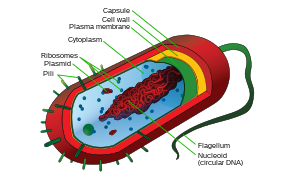| Revision as of 15:19, 21 September 2009 view sourceClueBot (talk | contribs)1,596,818 editsm Reverting possible vandalism by 70.167.141.206 to version by 69.243.241.71. False positive? Report it. Thanks, ClueBot. (772696) (Bot)← Previous edit | Revision as of 15:19, 21 September 2009 view source 70.167.141.206 (talk) →Classical interpretationNext edit → | ||
| Line 22: | Line 22: | ||
| Credit for developing cell theory is usually given to three scientists: ], ], and ]. In 1839, Schwann and Schleiden suggested that cells were the basic unit of life. Their theory accepted the first two tenets of ] (see next section, below). However the cell theory of Schleiden differed from modern cell theory in that it proposed a method of spontaneous crystallization that he called "Free Cell Formation"<ref>Schleiden, Matthias Jakob 1839,"Contributions to Phytogenesis"</ref>. In 1858, Rudolf Virchow concluded that all cells come from pre-existing cells, thus completing the classical cell theory. | Credit for developing cell theory is usually given to three scientists: ], ], and ]. In 1839, Schwann and Schleiden suggested that cells were the basic unit of life. Their theory accepted the first two tenets of ] (see next section, below). However the cell theory of Schleiden differed from modern cell theory in that it proposed a method of spontaneous crystallization that he called "Free Cell Formation"<ref>Schleiden, Matthias Jakob 1839,"Contributions to Phytogenesis"</ref>. In 1858, Rudolf Virchow concluded that all cells come from pre-existing cells, thus completing the classical cell theory. | ||
| <!-- LOL | |||
| === Classical interpretation === | === Classical interpretation === | ||
Revision as of 15:19, 21 September 2009

Cell theory refers to the idea that cells are the basic unit of structure in every living thing. Development of this theory during the mid 1600s was made possible by advances in microscopy. This theory is one of the foundations of biology. The theory says that new cells are formed from other existing cells, and that the cell is a fundamental unit of structure, function and organization in all living organisms.
History

The cell was first discovered by Robert Hooke in 1665. He examined very thin slices of cork and saw a multitude of tiny pores that he remarked looked like the walled compartments of a honeycomb. Because of this association, Hooke called them cells, the name they still bear. However, Hooke did not know their real structure or function. Hooke's description of these cells (which were actually non-living cell walls) was published in Micrographia.. His cell observations gave no indication of the nucleus and other organelles found in most living cells.
The first man to witness a live cell under a microscope was Antonie van Leeuwenhoek, who in 1674 described the algae Spirogyra and named the moving organisms animalcules, meaning "little animals".. Leeuwenhoek probably also saw bacteria. Cell theory was in contrast to the vitalism theories proposed before the discovery of cells.
The idea that cells were separable into individual units was proposed by Ludolph Christian Treviranus and Johann Jacob Paul Moldenhawer. All of this finally led to Henri Dutrochet formulating one of the fundamental tenets of modern cell theory by declaring that "The cell is the fundamental element of organization"
The observations of Hooke, Leeuwenhoek, Schleiden, Schwann, Virchow, and others led to the development of the cell theory. The cell theory is a widely accepted explanation of the relationship between cells and living things. The cell theory states:
- All living things are composed of one or more cells.
- Cells are the basic units of structure and function in living things.
- New cells are produced from existing cells.
The cell theory holds true for all living things, no matter how big or small, or how simple or complex. Since according to research, cells are common to all living things, they can provide information about all life. And because all cells come from other cells, scientists can study cells to learn about growth, reproduction, and all other functions that living things perform. By learning about cells and how they function, you can learn about all types of living things.
Credit for developing cell theory is usually given to three scientists: Theodor Schwann, Matthias Jakob Schleiden, and Rudolf Virchow. In 1839, Schwann and Schleiden suggested that cells were the basic unit of life. Their theory accepted the first two tenets of modern cell theory (see next section, below). However the cell theory of Schleiden differed from modern cell theory in that it proposed a method of spontaneous crystallization that he called "Free Cell Formation". In 1858, Rudolf Virchow concluded that all cells come from pre-existing cells, thus completing the classical cell theory.
- Inwood, Stephen (2003). The man who knew too much: the strange and inventive life of Robert Hooke, 1635-1703. London: Pan. p. 72. ISBN 0-330-48829-5.
- Karling JS (1939). "Schleiden's Contribution to the Cell Theory". The American Naturalist. 73: 517–37. doi:10.1086/280862.
- Moll WAW (2006). "Antonie van Leeuwenhoek". Retrieved 2008-11-25.
- Porter JR (1976). "Antony van Leeuwenhoek: tercentenary of his discovery of bacteria". Bacteriol Rev. 40 (2): 260–9. PMC 413956. PMID 786250.
{{cite journal}}: Unknown parameter|month=ignored (help) - Treviranus, Ludolph Christian 1811, "Beyträge zur Pflanzenphysiologie"
- Moldenhawer, Johann Jacob Paul 1812, "Beyträge zur Anatomie der Pflanzen"
- Dutrochet, Henri 1924, "Recherches anatomiques et physiologiques sur la structure intime des animaux et des vegetaux, et sur leur motilite, par M.H. Dutrochet, avec deux planches"
- Schleiden, Matthias Jakob 1839,"Contributions to Phytogenesis"